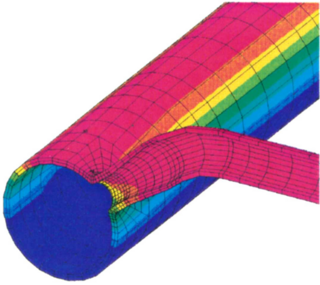
IMAS Fatigue Monitoring / general monitoring
Long term safety and reliability
on the basis of comprehensive surveillance

fatigue monitoring,
general monitoring,
monitoring after major refurbishment
special purpose monitoring
A seamless surveillance of loads and stresses is essential in nuclear power plants, in the frame of special purpose monitoring (for a limited time) or in the frame of an operational monitoring (parallel to operation).
A surveillance of causes for possible damage mechanisms is the central task within the integrity concept and within ageing management; consequently, this is part of regulatory demands.
On the basis of global and local monitoring system operation can be optimized and usage factors can be tracked and documented - important esecially regarding long term operation (LTO).
Special purpose monitoring tasks may be necessary to find the reasons for unexpected transients or to identify the causes for unexpected damage. Typical examples are thermal stratification effects or mixing of hot/cold media or dynamic events.
Fatigue monitoring
quantify fatigue - reduce fatigue, consequently
Monitoring of loads and stresses was introduced in nuclear technology under the heading of fatigue monitoring, initially. On the basis of positive experience, monitoring tasks were successively expanded to become a central instrument for to guarantee integrity and function.
The main goal of fatigue analysis in the design phase is to prove that the fatigue usage for the applied / specified service life (usually 40 years when the power plants are built) is less than 1. The calculation depth is also based on this goal. The conservatism of this procedure usually is not quantified and therefore an extrapolation to 60 years of operation, for example, is often not successful. In addition, the extrapolations can be questioned by new (postulated) load cases.
Therefore, tracking the real fatigue usage of relevant systems and components based on monitoring is beneficial. Monitoring of the fatigue-related loads results in more precise knowledge, which operational processes have a particular impact on fatigue. On this basis, measures to optimize operating modes can be derived to reduce the increase of fatigue usage. This enables long-term safe and reliable operation.

As operational experience shows, there are systems and components that are only subject to global loads, on the one hand, but on the other hand there are also system and component regions that are exposed to significant local loads. In the first case (only global loads), global monitoring based on operational instrumentation is sufficient, while local loads also require local monitoring.
All relevant systems and components are monitored with our fatigue monitoring system. Both the global signals (operational measuring points) and the signals from the local measuring points (separate instrumentation) are recorded and evaluated.
The operational fatigue monitoring or more generally: the monitoring of loads and stresses is an important measure in the context of aging management, in the context of periodic safety analysis and especially in connection with service life extensions (LTO).
- We supply and service systems for fatigue monitoring of relevant systems and components.
- We provide all steps of evaluation and assessment of the measured data.
measurements during commissioning or after major refurbishment,
event-related special measurements
In many cases, it is of interest to determine the loads that actually occur and the resulting stresses on systems and components, e.g.
- for verification of pipeline calculations before / after modifcations,
- to specify boundary conditions for calculations,
- to prove the proper function of existing / new pipe supports,
- for evaluation of damages and
- for preventive monitoring.
To record the relevant loads, we carry out both quasi-static and dynamic measurements (for short-term use or for permanent monitoring) as a service.
- We monitor and evaluate loads and stresses on pipelines, fittings, containers, etc.

